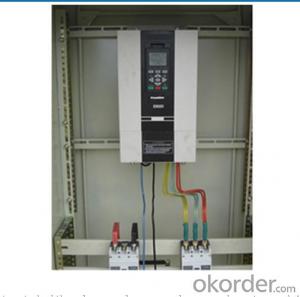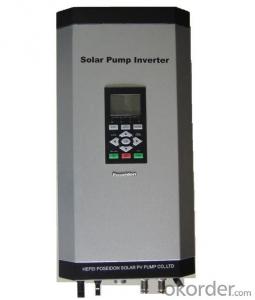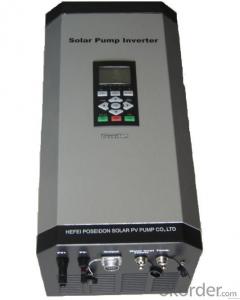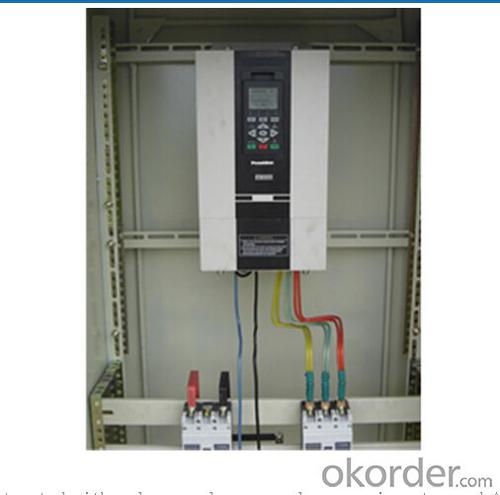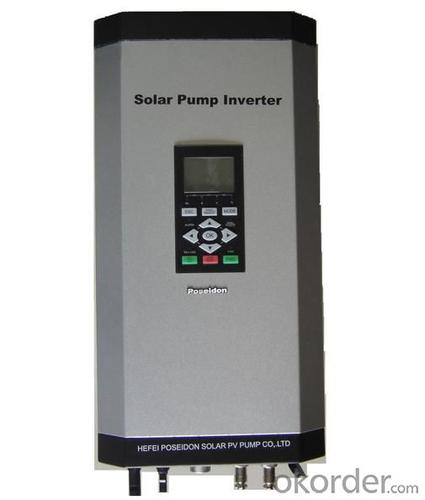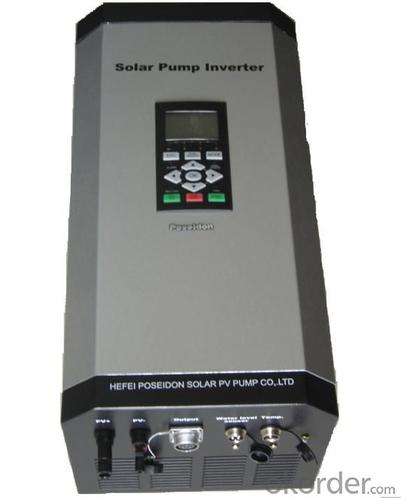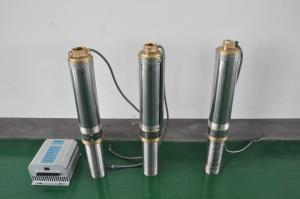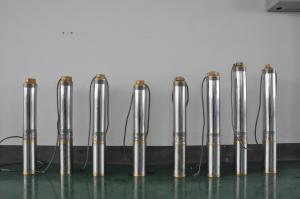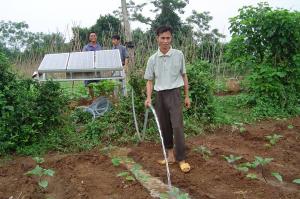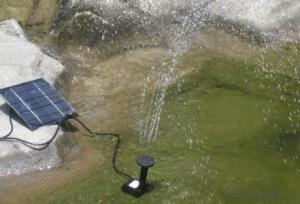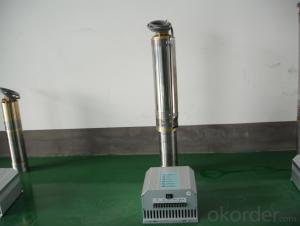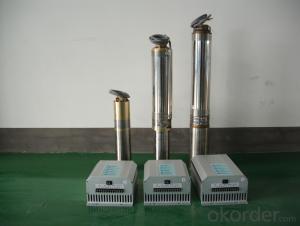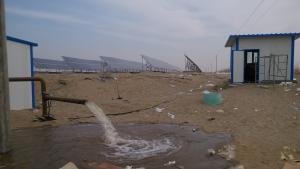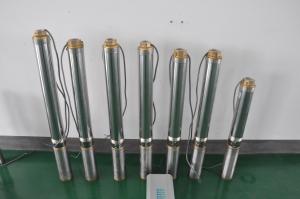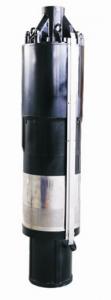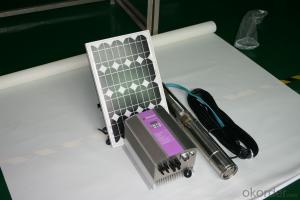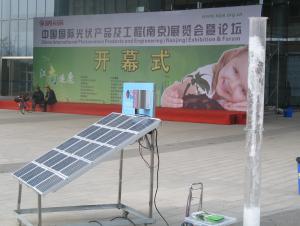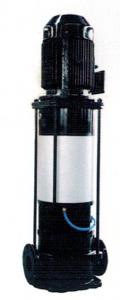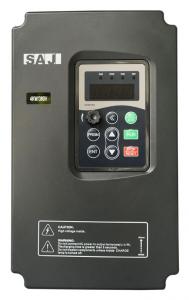Dankoff Solar Pump FCPM37KH Inverter
- Loading Port:
- China Main Port
- Payment Terms:
- TT OR LC
- Min Order Qty:
- -
- Supply Capability:
- -
OKorder Service Pledge
Quality Product, Order Online Tracking, Timely Delivery
OKorder Financial Service
Credit Rating, Credit Services, Credit Purchasing
You Might Also Like
Solar pump inverter FCPM37KH Product Description:
Solar water pumping system is constructed with solar panel array,solar pump inverter and AC water pump, DC current produced from solar panel will be delivered to solar pump inverter,and it will convert it into AC current to drive water pump,and will automatically regulate output frequency according to sun radiance intensity,maximally realize MPPT tracking function.
Features
Adopting the proposed dynamic VI maximum power point tracking (MPPT) control method, with fast response, and reliable operation, achieves efficiency of 99%.
Designed with variable frequency driver, greatly improves efficiency
Extremely high efficiency
Digital mode control, with automatic operation and manual operation mode options
Complete protection functions
Adopts intelligent IPM module, with high reliability
LCD display and operation panel, in real time presents operating data
Optional for water level measurement and control circuit
Applicable for general ACC pumps, like centrifugal pump, piston pump etc.
Independent intellectual property; Highly effective, the redundant reliability, exempts the maintenance and the long life.
The pumps are soft started, fully protected.
No batteries are used. So better Sunlight, more water.
Datasheet.
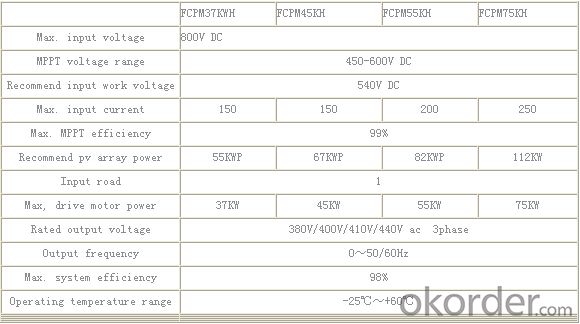
- Q: Can a solar pump be used for water circulation in hot tubs or spas?
- Yes, a solar pump can be used for water circulation in hot tubs or spas. Solar pumps are designed to circulate water using solar energy, making them an eco-friendly and cost-effective option for hot tubs or spas. They can help maintain water quality, prevent stagnation, and provide the necessary filtration and circulation required for a relaxing and enjoyable spa experience.
- Q: How do I calculate the solar energy required for running a solar pump?
- To calculate the solar energy required for running a solar pump, you need to consider a few factors: 1. Determine the power consumption of the pump: Find out the power rating of the solar pump, usually measured in watts (W). This information can usually be found in the pump's specifications or user manual. 2. Estimate the daily energy consumption: Multiply the power rating of the pump by the number of hours it runs per day. For example, if your pump is rated at 500W and runs for 4 hours a day, the daily energy consumption would be 500W x 4 hours = 2000 watt-hours (Wh) or 2 kilowatt-hours (kWh). 3. Account for efficiency losses: Solar panels are not 100% efficient, so you need to consider efficiency losses when calculating the required solar energy. A common rule of thumb is to assume an efficiency of around 70-80% for solar panels. To account for this, divide the daily energy consumption calculated in step 2 by the assumed panel efficiency. For example, if your daily energy consumption is 2 kWh and the assumed panel efficiency is 75%, the required solar energy would be 2 kWh / 0.75 = 2.67 kWh. 4. Consider the solar insolation: Solar insolation refers to the amount of solar radiation received per unit area in a given time. It varies depending on location and time of year. Research or consult local weather data to determine the average daily solar insolation for your area. This is usually given in kilowatt-hours per square meter per day (kWh/m²/day). 5. Calculate the required solar panel capacity: Divide the required solar energy (calculated in step 3) by the average daily solar insolation (step 4) to determine the required solar panel capacity. For example, if the required solar energy is 2.67 kWh and the average daily solar insolation is 5 kWh/m²/day, the required solar panel capacity would be 2.67 kWh / 5 kWh/m²/day = 0.534 square meters (or 534 square centimeters). Keep in mind that this calculation provides an estimate and actual results may vary based on factors such as shading, panel orientation, and efficiency variations. It is always recommended to consult with a solar energy professional or supplier for a more accurate assessment tailored to your specific requirements.
- Q: Can a solar pump be used for water supply in disaster-prone areas?
- Yes, a solar pump can be used for water supply in disaster-prone areas. Solar pumps are an effective and sustainable solution as they operate on renewable energy, reducing dependency on traditional power sources. They can provide a reliable water supply even during emergencies when electricity grids may be disrupted. Additionally, solar pumps are easy to install, require minimal maintenance, and are cost-effective in the long run, making them a suitable choice for disaster-prone areas.
- Q: Can a solar pump be used for water supply in oil refineries or petrochemical plants?
- Yes, a solar pump can be used for water supply in oil refineries or petrochemical plants. Solar pumps are highly versatile and can be used in various industrial applications, including providing water for industrial processes in oil refineries and petrochemical plants. They offer a sustainable and cost-effective solution by harnessing solar energy to power the pumps, reducing reliance on traditional energy sources and minimizing operational costs. Additionally, solar pumps are often designed to be highly reliable and can operate in remote locations with minimal maintenance requirements, making them suitable for the specific needs of oil refineries and petrochemical plants.
- Q: How do solar pumps handle water with high ammonia or chemical content?
- Solar pumps are typically not designed to handle water with high ammonia or chemical content. These pumps are primarily used for pumping clean water from wells, boreholes, or other sources. Water with high ammonia or chemical content can be corrosive and may damage the pump components. In such cases, it is recommended to use specialized pumps or pre-treatment methods to remove or neutralize the ammonia or chemicals before pumping with a solar pump.
- Q: Are there any water quality requirements for a solar pump?
- Yes, there are water quality requirements for a solar pump. It is important to ensure that the water being pumped is clean and free from contaminants such as debris, sediments, and chemicals. This is essential to prevent damage to the pump and ensure its optimal performance and longevity. Additionally, the quality of water being pumped may also impact the overall efficiency and effectiveness of the solar pump system. Therefore, it is advisable to regularly conduct water quality tests and implement appropriate filtration or treatment measures if necessary.
- Q: Is it possible to retrofit an existing pump system with solar power?
- Yes, it is possible to retrofit an existing pump system with solar power. Retrofitting involves integrating solar panels and a solar power converter into the existing system. The solar panels would be installed in a location where they receive maximum sunlight exposure, typically on the roof or nearby area. The solar power converter is then connected to the existing pump system, allowing it to draw power from the solar panels. This setup enables the pump system to operate independently of the electrical grid, reducing or even eliminating the need for conventional electricity. Retrofitting with solar power offers several advantages, including lower operating costs, reduced carbon emissions, and increased energy independence. However, it is important to consider the specific requirements of the pump system and ensure that the solar power capacity is sufficient to meet the system's needs.
- Q: Are there any safety concerns related to using a solar pump?
- Yes, there are some safety concerns related to using a solar pump. One potential concern is the risk of electrical shock due to the use of high voltage equipment. It is important to ensure that the solar pump is properly installed and grounded to minimize this risk. Additionally, if the solar panels are not installed securely, there is a potential for them to fall and cause injury. Regular maintenance and inspection of the system is necessary to address any safety concerns and ensure safe operation.
- Q: How does a solar pump help in reducing the use of genetically modified crops?
- A solar pump helps in reducing the use of genetically modified crops by providing sustainable and cost-effective irrigation solutions. By utilizing solar energy to power the pump, farmers can access a reliable water source for irrigation purposes without relying on expensive and environmentally harmful methods such as diesel pumps. This enables farmers to grow crops using natural water sources instead of genetically modified seeds that are often engineered to withstand drought or other adverse conditions. Therefore, the use of solar pumps promotes the cultivation of traditional, non-genetically modified crops, contributing to a reduction in the reliance on genetically modified crops.
- Q: Can solar pumps be used for water supply in remote forestry or logging sites?
- Yes, solar pumps can be effectively used for water supply in remote forestry or logging sites. These sites often lack access to electricity grids, making solar pumps an ideal solution for water extraction and distribution. Solar pumps are cost-effective, environmentally friendly, and require minimal maintenance. They can be easily installed in remote locations, utilizing solar energy to power the pumps and provide a reliable water supply for various forestry or logging activities.
Send your message to us
Dankoff Solar Pump FCPM37KH Inverter
- Loading Port:
- China Main Port
- Payment Terms:
- TT OR LC
- Min Order Qty:
- -
- Supply Capability:
- -
OKorder Service Pledge
Quality Product, Order Online Tracking, Timely Delivery
OKorder Financial Service
Credit Rating, Credit Services, Credit Purchasing
Similar products
Hot products
Hot Searches
Related keywords
